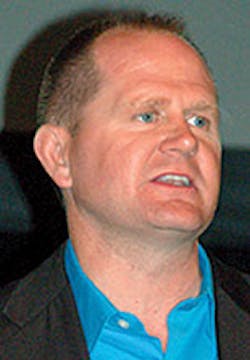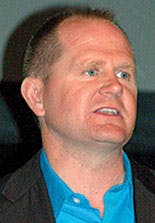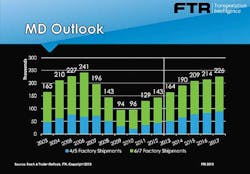The outlook for trailers, trucks, and the customers who buy them examined in detail at annual FTR seminar
CAN the commercial truck and trailer industry be able to handle a stable market?
People who make a career out of manufacturing or
selling trucks and trailers routinely cope with 20-30% swings in demand. That has changed recently, and the stability may be hanging around a little longer.
According to speakers at the recent FTR Transportation Conference, business should remain relatively unchanged from its current healthy levels.
Here are some of the highlights from an array of experts who gave their views during the two-day conference:
MARKET UPDATE AND OUTLOOK
Eric Starks, president, FTR
Demand for truck trailers may fluctuate month to month, but at the end of this year and next, expect total trailer production to be just a little higher than it was in 2012.
Speaking at his company’s annual seminar in Indianapolis, FTR President Eric Starks believes trailer orders will surge in November and December and will remain strong through February. This will offset the decline experienced this summer.
“Orders need to pick up toward the mid-teens over the next few months to hit our fourth quarter forecast,” Starks said. “July order activity was below 13,000.”
He believes trailer manufacturers could close out 2014 in great shape.
“If fleets can push rates higher in the first half of 2014, there should be upside pressure to the second half of the year,” he said.
FTR counted 232,000 truck trailers produced in the United States last year. The company believes production will reach 236,000 trailers in 2013. The forecast for 2014 calls for 237,000 trailers to be produced. That number is expected to edge down to 210,000 in 2015.
The forecast is influenced by a variety of factors:
•The economy is growing slowly.
•Fleets are improving their utilization of equipment.
•Federal regulations are expected to adversely affect fleet efficiency, increasing the need for more equipment.
•Freight will increase only slightly in the coming months. Freight rates have been flat or down year-over-year, putting pressure on fleet margins.
•Fleets will remain cautious when making purchasing decisions.
•The industrial sector is strengthening, posting a modest gain in August.
•The greatest risk for production to fall short of expectations will be in the last quarter of this year and the first quarter of 2014.
On the truck side, Starks said that orders should begin picking up in the next several months. A seasonal spike is expected in November, December, and January.
How effectively have fleets been utilizing equipment? The historical average is 90%. The utilization rate has been below average since 2005, falling to near 70% for trucks and 75% for trailers in 2010. It is back to 90% now and FTR is projecting that it will exceed 95% for trailers next year. This suggests some upside pressure to the equipment market in 2014, Starks said.
Details are available in the FTR “Truck And Trailer Outlook” report containing detailed unit forecasts for
trailers as well as for medium- and heavy-duty trucks.
WHAT FLEETS ARE THINKING
Chris Kemmer, president, CK Marketing
In the near term, fleets are planning to increase purchases of trucks and dial down their purchases of trailers, according to the results of a survey Kemmer’s company conducted between July 17 and 26.
The CKCVR Trailer Index moved down 24% in the third quarter and was 36% lower than its year-earlier level, Kemmer said. The index factors the percentage of survey respondents who plan to buy trailers and the number of trailers they plan to buy. First quarter 2008 serves as the reference point. The decline in the index was the result of fewer fleets indicating they plan to purchase trailers as well as a decrease in the size of the orders being planned.
Total volume of planned trailer orders is lowest since the fourth quarter of 2011 and represents an 86% drop from a year ago.
Utility had largest share this quarter. Tankers were being ordered by 27% of those placing orders but at low
volumes. Twenty-three percent are ordering reefers, and 36% ordered dry vans.
An estimated 60% of trailer orders came from fleets that operate between 100 and 999 units. Few small fleets appeared to be ordering trailers. The average order was just under 10 units. However, the smallest fleets seemed to be the ones most likely to increase capacity.
Most of the orders will be for replacement. Few fleets are expanding. Of the power units that fleets expect to purchase, 97% will be replacement units. Only 3% will be bought in order to increase the size of the fleet.
“We continue to get information that capacity is tightening – with fewer and fewer fleets reporting excess capacity and more and more reporting that they need new equipment,” Kemmer said.
Kemmer’s research is based on surveying group of dedicated “fleet advisors” who are decision makers at commercial vehicle fleets (for-hire, private and government). The group consists of approximately 150 fleets of various sizes. They include truckload and LTL for-hire fleets in the US and Canada. Private fleets include energy suppliers, food service, building material, farm products, wholesale/retail, caskets, hazardous materials, and waste haulers. Government fleets also participate.
“We question them periodically about equipment purchasing plans, spec’ing plans and other issues affecting their operation,” she explained. “The group is representative of industry, and collected data
generally follows industry activity.”
Among the comments fleets made during the latest survey:
• Fuel price volatility and continued CARB compliance issues depress fleet outlook.
• A shortage of drivers is placing constraints on fleets’ ability to expand. More than 60% said they need drivers now, and a similar percent reported that they would add more vehicles to their fleet if they could hire the additional drivers.
• Sales continue to trend up, according to a private beverage distributor.
• Business is still very volatile and less predictable
• Business is strong, according to a large transportation/warehouse/logistics company.
Economic outlook
William Strauss, senior economist and economic advisor, Federal Reserve Bank of Chicago
Trucks and trailer sales tend to flourish when the economy is strong. The Federal Open Market Committee (FOMC) outlook is for the US economy to expand at a pace around trend in 2013 (2.0% in 2012, 2.1% in 2013) and above trend in 2014 (2.8%), Strauss said.
Among the points Strauss made:
Employment is expected to rise moderately, with the unemployment rate edging lower. Employment fell by more than 8.7 million jobs between Dec 2007 and February 2010. It has since added 6.8 million jobs. Unemployment rate has fallen by 2.7 percentage points and is forecast to decline below about 7% in 2014. FOMC Central Tendency 5.9-6.2% in 2015 and 5.4-5.9% in 2016.
• Slackness in the economy will lead to a relatively contained inflation rate.
• Manufacturing should increase at a pace slightly above trend in 2014.
• The “Great Recession” ended in June 2009, but the economy expanded by just 1.6% compared with a year earlier.
• Existing home prices fell 30% during the recession, but have begun to increase. The forecast calls for a very gradual recovery in housing.
• Oil prices, when inflation is considered is now cheaper than 30 years ago.
• Sales of light-duty vehicles have reached pre-recession levels. After rising by 13% in 2012, vehicle sales are predicted to rise around 8% this year and 3% next year.
• Industrial output in manufacturing fell sharply during the recession but has risen strongly over the past 50 months. It has recovered 82.2% of the loss during the recession. But manufacturing jobs have only recovered 22% of the jobs lost during the downturn.
• Manufacturing capacity utilization has been rising since June 2009.
• Economic recovery has been broad-based, with motor vehicles, primary metals, and machinery manufacturing leading the way.
• The supply managers’ composite index has improved.
Total trailer loads have continued to rise.
• After a surge earlier in the year, heavy-duty truck orders have moderated. The backlog-to-build ratio for heavy trucks has fallen to fairly low levels.
• Medium-duty trucks have continued to move higher. Orders have moved from a low of near 200 per day in late 2009 to an average of 800 per day this year.
• Industrial production is forecast to rise slightly this year, accelerating in 2014.
• The targeted federal funds rate is expected to remain low through 2015.
Regulatory outlook
Annette Sandberg, CEO, TransSafe Consulting
Sandberg, a former deputy administer at the Federal Motor Carrier Administration as well as at the National Highway Traffic Safety Administration, pointed out many of the regulatory challenges that trailer customers are facing. Among them:
• Drug and alcohol database is a notice of proposed rulemaking that was supposed to have been out this summer. The agency has delayed the rulemaking until this fall. It will require every motor carrier to submit the results of every drug and alcohol test that they perform on a driver. This rule is bound to take some drivers out of the system, she said.
• Patterns of violations. This is a proposal that will allow FMCSA to shut down carriers if their safety record is sufficiently poor. There is considerable concern in the industry about how far the government will reach in regard to this rule. The comment period for this proposal has closed, and should be published sometime next year.
• Speed limiters. This rule has been requested by the American Trucking Associations and others. This rule would require manufacturers to install speed limiters on Class 8 trucks. The National Highway Traffic Safety Administration has published an announcement, and the comment period has closed. The proposed rule is expected to come out in the spring of 2014. She expects perhaps a two-year period that would give truck manufacturers and others a chance to implement whatever requirements are involved.
• Electronic logging devices (ELD). The proposal has been put on hold for additional study. No action is anticipated in this area for a year or two.
• Prohibition on coercion. This portion of MAP-21 requires that regulations governing commercial motor vehicle safety so that truck drivers are not forced to violate DOT rules. It is intended to apply to motor carriers, shippers, receivers, or transportation intermediaries and others who may have reason to pressure drivers to bend the rules. The proposal, which gives FMCSA much broader authority, is expected to be out early next year.
• Safety fitness determination.
Other regulatory activity that fleets are facing:
• Medical Examiners Certification Integration. FMCSA proposes to require certified medical examiners (MEs) performing physical examinations on drivers of commercial motor to report results of all completed commercial drivers’ physical examinations (including the results of examinations where the driver was found not to be qualified) to FMCSA by close of business on the day of the examination. This would include all CMV drivers who are required to be medically certified to operate in interstate commerce, not only those who hold or apply for commercial learner’s permits (CLP) or commercial driver’s licenses (CDL). Results would go into a government database.
• Driver Vehicle Inspection Report. An NPRM was published in August. Sandberg described this as a bit of regulatory relief. Drivers do not have to keep pieces of paper if the truck passes the walk-around inspection. However, it will be hard for fleets to prove that they are conducting inspections in the first place unless they have documentation.
• Electronic Stability Control. Sandberg said a final rule is expected from NHTSA in March 2014. The rule, she said, definitely will increase the purchase cost of new heavy-duty trucks.
• New Entrant Proficiency Exams. This proposal is on the agenda but the timing is uncertain. This will require anyone who applies for a new DOT number to pass an exam that would show that they are familiar with the regulations that apply to them.
• Increase in minimum insurance? There is some movement in Congress to significantly increase insurance requirements for motor carriers. This could drive some small carriers out of business, Sandberg said.
FMCSA to complete study on HOS restart provision. This may be out by the end of the year.
The Government Accounting Office review on “Wetlines” Rulemaking at PHMSA. The GAO said the original proposal to require tank truck carriers to purge the lines before moving the truck was not a good idea
Sandberg focused particularly on the concept of electronic logging devices. This method of keeping track of driver activity is expected to reduce the instance of fraudulent recordkeeping and more accurately track compliance with Hours of Service regulations.
“When we take the fudge factor out of drivers’ logs, it really will change the industry,” Sandberg said. ♦
About the Author
Bruce Sauer
Editor
Bruce Sauer has been writing about the truck trailer, truck body and truck equipment industries since joining Trailer/Body Builders as an associate editor in 1974. During his career at Trailer/Body Builders, he has served as the magazine's managing editor and executive editor before being named editor of the magazine in 1999. He holds a Bachelor of Journalism degree from the University of Texas at Austin.






